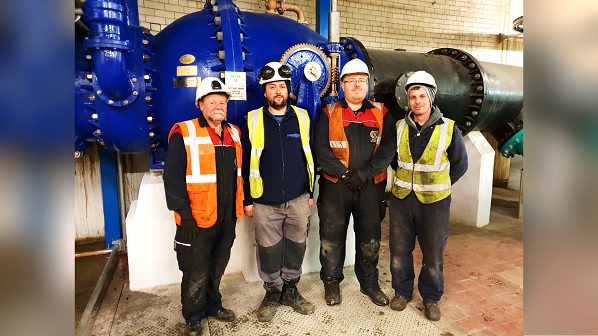



 What's the story?
What's the story?
Ladybower Reservoir is a large Y-shaped reservoir, originally built in the period between 1935 and 1943 and is located in the Upper Derwent Valley, at the heart of the Peak District National Park. The capacity of the reservoir is 2.7 million cubic metres and was officially opened by King George VI on 24th September 1945.
In 2018, during statuary inspections concerns were raised by the reservoir's panel engineer that the Larner-Johnson scour Needle valves in the dam valve tower were not shutting off correctly. The Blackhall valvologists were called in to inspect and diagnose the problem and conduct feasibility studies to provide the best possible refurbishment options in 2018.
On-Site Inspection
On inspection we found that the problem was down to an internal failure of the operating mechanism, with everything pointing towards the pinion wheel Key. Due to lack of maintenance the operating forces had increased over the years to a point at which the internal components had failed causing loss of control over the plunger.
To carry out this repair the valves were to be removed from the pipeline. The other major concern was the amount of cavitation damage on the face of the Cast Iron Plunger, it looked like approximately 1” of material had been completely eroded away. These valves do see a high inlet pressure and are subjected to very high velocities. These valves belonged to the earlier design Larner-Johnson valves where a cast Iron Plunger was used with Bronze faces, while on our modern design we would use a Stainless-Steel Plunger. Our recommendation was to remove the valve from the pipeline and chamber and return it to our works for a full service and upgrade, including a new Stainless-Steel Plunger and body liner. This would ensure that the valve would be fit for another 90 years+.
A comprehensive method statement was issued to North Midland Construction/Severn Trent Water which comprised the objective, preparation work, list of Plant, PPE And Safety Equipment, Work Scope, Safety Policy, contingency plans and Emergency contacts. All Works were carried out strictly in accordance with the Risk Assessment Method Statements (RAMS). These included RAMS for third party companies i.e. lifting and crane hire company, Severn Trent Water ensured we had double isolation, and the system fully the drained. All working personnel on site were also briefed on their own personal safety plan and any site-specific risks.
The removal of the valve took 3 days. The site preparation work took around one week. One of the biggest challenges was designing and installing a bespoke lifting gantry above and around the valve to allow the valve to be lifted from the pipeline and positioned under the removal point in the basement roof. Once the Gantry was installed and load tested onsite, the valve and associated pipework were removed from the pipeline and the valve positioned under removal point. Due to the lift Radius a 150 ton crane was needed to lift the 7.5 ton valve out of the basement and loaded onto the transportation to return the valve to our works for a full refurbishment.
The valves were then delivered to our Brighouse facility to be stripped and inspected. A detailed strip down and condition assessment report was presented to NMC / Severn Trent Water which concluded that the valve had suffered major damage to its’ operational components. The failure of these components resulted in total loss of operational control of the valve. If the pilot valve had been in the closed position when failure of these components took place, a resulting build-up of pressure would have occurred causing the plunger to be slammed shut. This pressure surge could have caused catastrophic failure of the valve and connecting pipework/equipment.
The main areas of damage as seen in strip and inspection report were-
• Rack & Pinion.
• Plunger suffered major cavitation/erosion damage – mainly to the iron section of the assembly and was no longer fit for purpose.
A detailed recommendation report was submitted listing the parts that were to be refurbished, replaced and enhanced as they were out of their operational tolerances being badly worn.
This included enhancing or replacing the plunger with more superior material i.e stainless steel and refurbishing the body further by repainting it with a glass flake vinyl ester acrylic co-polymer paint having a superior resistance against various chemical environments. The other parts which were recommended to be refurbished were envelope parts and the inlet section liner, whilst also replacing the rack and pinion, pilot valve, fasteners, seals and sundries. The cross shaft which was reported to be a contributing factor for the damage of rack and pinion was recommended to be upgraded in design for it to retain the thrust ring more positively hence acting as a preventative safety measure.
All the operational and moving components were renewed and enhanced as per the detailed recommendations made in Strip Down and Inspection Report therefore ensuring a minimum operating life to exceed the original life of 90 years. The assessment of asset life is also based on the presumption that regular inspection and cycling of valves is maintained throughout their service life, and that any necessary interim service work is carried out in a timely manner.

After reinstallation of the valve it was noted that the operating torque post the repair was significantly lower than the site usage data for the pre-repaired valve.
Torques were incredibly low post repair and refurbishment. When the valve was commissioned the customer's required flow rates and emergency discharge rates were achieved.
Blackhall is proud to be environmentally and socially responsible in everything we do. The immediate benefit of refurbishing good valves lies in Carbon Footprint Impact. While replacing old with brand new might seem to be a favourable option but taking all its aspects such as manufacturing and transporting often foreign valves made in East Asia into account, it becomes evident that the carbon footprint is shockingly higher. This is how Ladybower Reservoir achieved safety with minimal impact to carbon footprint.